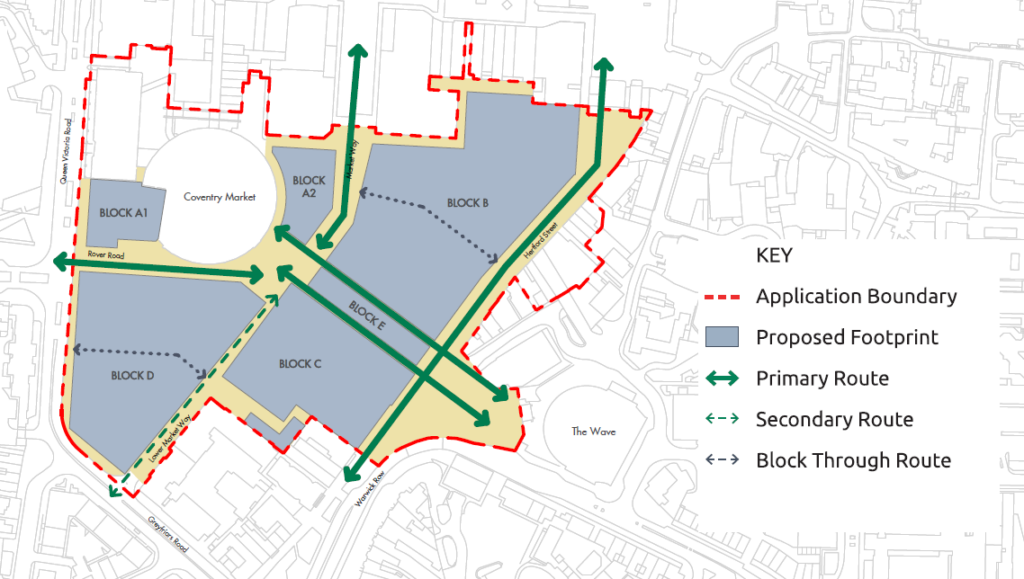
Shearer Property Regeneration Ltd. has submitted a revised scheme for the redevelopment of the southern part of the City Centre. The Coventry Society objected to the previous scheme, which was approved earlier in the year.
The revised scheme increases the maximum number of housing units from 1300 to 1500 and the maximum amount of commercial floorspace is reduced from 37,500 sq metres to 20,000 sq. metres. We are pleased to see that the revised scheme now includes 20% affordable housing.
CovSoc comments on the new application are as follows:
Planning Application S73/2022/3160 – Revisions to City Centre South Development
The Coventry Society OBJECTS to this planning application for the following reasons:
1. Whilst we acknowledge that the scheme now includes 20% Affordable Housing, this still does not comply with policy H6 of the Coventry Local Plan 2017, which requires a 25% contribution, as does the NPPF. In order to meet the housing needs of the city, this target should not be abandoned. If the scheme cannot support a 25% contribution to affordable housing, then it is not a viable scheme and therefore poses a risk to the City Council and the people of Coventry and should not be implemented.
2. In order to contribute to the levelling up agenda, we believe that the balance between affordable rented units and intermediate affordable housing should be 60:40 rather than 50:50. Also to meet Coventry’s pressing housing needs, affordable rental units should be social rent (50% of local market rents) rather than affordable rents (up to 80% of local market rents).
3. The maximum housing number parameter of the hybrid application has changed from 1300 –1500 units, but not the minimum housing provision which remains at 900 units. As the development has intensified, we would expect the minimum housing provision to be increased in line with the maximum provision – to 1100 units. With such a huge public subsidy (£95.5 Million from the WMCA), we feel that there should be a guaranteed number of housing units provided by the scheme. An alternative approach that we would support would be to abandon minimum and maximum unit numbers and set a target figure with penalties if this is not achieved.
4. It is not clear to us whether the proposal to amend the Section 106 agreement through a deed of variation is part of this application, but we believe that this should be covered by a new planning condition.
5. We believe that a development on this scale should be design led rather than merely set out as blocks as in the current application. We feel that the long, almost unbroken frontage provided by Blocks B, E and C will create an unacceptable “wall” that will not be possible to make attractive. We would recommend that the “wall” is shortened by excluding the Litten Tree from the development. Such exclusion would support the cultural aspirations of the scheme.
6. Further to the last point, we feel that the narrowing of Block E and the creation of two rather narrow walkways between the Market and the Wave, will fail to link the two areas visually as stated in the application.
7. It is not clear what the role or function of Block E, the Pavilion, is. Whilst we welcome the reduction of the height of this block, the block is now too narrow to create an attractive feature. It is not possible to service the building without crossing publicly accessible pedestrian areas. We would recommend that the building be omitted entirely, permitting a wide visual and communication corridor between the Market and the Third Spire. This could be a most attractive part of a scheme, reflecting the boulevard feel of Market Way and Hertford Street and assisting in mitigating the loss of city’s important 20th Century heritage.
8. We believe that there has been a material change in circumstances in relation to the market environment for retailing since the original scheme was designed and that the revised scheme has not taken adequate account of this. The prospect of national chain stores taking up all the available units in this scheme (reduced as it is) is not realistic. The scheme makes no, or inadequate, provision for independent retailers and we feel that provision should be made for “affordable retailing” to try to keep some independent retailers in the city centre. Independent retailers are typically locally owned, more resilient to market changes and less subject to the vagaries of nation-wide brand management.
